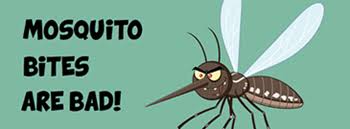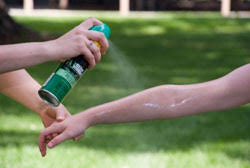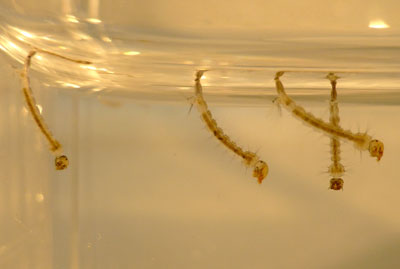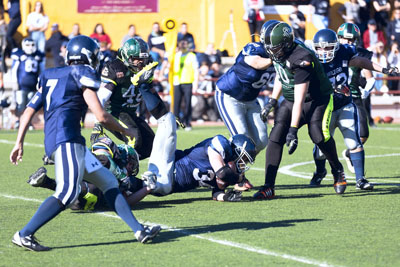DHHS → MeCDC → Disease Surveillance → Epidemiology → Vectorborne → Mosquito Prevention and Property Management
Mosquito Prevention and Property Management

Reducing your exposure to mosquitoes lowers your chance of getting a mosquito-borne illness. Mosquito season in Maine usually begins in the spring and ends in the fall. If you work or play outdoors, you should:
- Wear an EPA approved repellent.
- Wear long pants and long-sleeve shirts to lessen the amount of uncovered skin.
- Try to minimize your time outside between early evening and early morning. This is when mosquitoes in Maine are most active. [1, 2]
What types of repellents should I use to prevent mosquito bites?
- The effectiveness of a repellent depends on the active ingredient and the concentration, among other things. [3, 4]
- Use repellents that contain 20% DEET or greater on skin to prevent mosquito bites for several hours. [3, 5] Other EPA-approved repellents for use on skin include picaridin, IR3535, and oil of lemon eucalyptus. [4]
- Oil of lemon eucalyptus products should not be used on children under the age of three. Other ingredients, including DEET, do not have age restrictions. [6]
- Use permethrin on clothing and gear. Treated clothing lasts for several washes and is very effective at preventing mosquito bites. Permethrin is NOT approved for use on skin. [4, 7]
- Some repellents have essential oils such as citronella, peppermint oil, geranium oil, garlic oil, and others which do not require EPA registration. There is little data on their effectiveness and safety. The research that is available shows that they are have a short duration of protection. [3, 4, 5]
- Always follow the instructions on the label.

Are schools and daycares allowed to apply repellents to children?
- Yes, schools and daycares can apply repellents to minors if a parent or legal guardian has given their permission. [8]
- Workers should use an EPA approved repellent and always follow label instructions.
How can I reduce mosquito habitats around my yard? [9]
- Water Management – Mosquitoes need standing water (water that is not moving) to breed. To reduce breeding sites:
- Locate and remove any sources of water including unused pools, old tires, uncovered trash bins, buckets, and flower pots. [10]
- Drill holes in containers that may hold water.
- Clean clogged gutters and make sure downspouts are positioned to prevent water from pooling. [11]
- Refresh any source of standing water at least once a week to eliminate mosquito larva. This includes children's pools, birdbaths, and animal water dishes.

- Prevent access to your home – Install window and door screens and make sure there are no tears, rips, or holes.
- Eliminate adult resting sites – Cut back or remove dense brush in your yard. Keep your grass mowed short.
- Commercial traps – Commercial traps that use carbon dioxide and octenol as attractants can be effective. [12] For best results, traps should be placed:
- In a location between the breeding area and where people are
- 30-40 feet away from patios, picnic tables, and other places where people are
- Upwind from the mosquito breeding area
- In an open area and not in high grass
- In the shade
- Encourage Natural Predators - Dragonflies, bats, birds, frogs, and mosquito-eating fish may help naturally control mosquitoes. Research shows that they may be limited in their effectiveness. [13, 14]
How can I chemically control mosquitoes?
- Target adults in the landscape or larvae in water. Larval control tends to be more effective.
 Larval control – Larvicides include growth regulators, surface films, bacteriologic agents, and organophosphates. Larvicides target a certain stage of development. This means that the timing of chemical application is important. [15] There are some restrictions on using larval control products on natural bodies of water. [16]
Larval control – Larvicides include growth regulators, surface films, bacteriologic agents, and organophosphates. Larvicides target a certain stage of development. This means that the timing of chemical application is important. [15] There are some restrictions on using larval control products on natural bodies of water. [16]- Adult control – Spraying a low-volume chemical mist can kill adult mosquitoes on contact. These pesticides include natural pyrethrins, pyrethroids, and organophosphates. Usually these products need repeat applications, since they do not kill larva. [17, 18]
- Be sure to hire a state certified and licensed pesticide applicator. To find a licensed applicator in your area, contact the Maine Board of Pesticide Control at 207-287-2731 or email pesticides@maine.gov.
Do mosquito sprays affect other animals?
- Pesticides may pose a risk to human, animal, insect, and plant health. [19, 20, 21] Always read and follow the instructions on pesticide labels.
- Discuss the chemicals to be used and their potential environmental impacts when hiring a professional mosquito control company.
- Using an Integrated Pest Management (IPM) approach may help reduce the effects of pesticides. [22, 23]
What is Integrated Pest Management?
- Integrated Pest Management (IPM) is a best practice for managing pests that helps protect the health and environment while minimizing the use of pesticides.
- This includes prevention, regular pest monitoring, property management, education, and communication.
- To learn more about IPM, see the Department of Agriculture, Conservation, and Forestry's website on IPM.
Why are some towns spraying for mosquitoes while other towns are not?
- Some towns spray for mosquitoes to prevent mosquito-borne illnesses or in response to a positive mosquito pool or human case. The most common reason towns spray is because mosquitoes are a nuisance.
- There are some towns in Maine that have restrictions or bans on pesticide use.
Should I stay indoors when mosquitoes are out?
- It is not necessary to stay indoors when mosquitoes are out. Mosquitoes in Maine are active between dusk and dawn. [1, 2, 24] Other areas of the country have mosquito species that are active during the day.
- Mosquitoes in Maine are usually active from spring into the fall.
- Make sure to protect yourself against mosquitoes by using an EPA approved repellent and wearing protective clothing when you are outside. Protective clothing includes long-sleeves and pants, high boots, and insect netting worn on the head or entire body.
How far can mosquitoes fly?

- Adult mosquitoes can fly a few hundred feet [25] to several miles [26] to find food or breeding habitat.
Why is moving sports practices or games a recommendation if a school is near a human case or a positive mosquito pool?
- Many sports practices and games happen in the late afternoon and early evening. This is the time of day when mosquitoes that can carry Eastern Equine Encephalitis (EEE) and West Nile virus (WNV) are most active. [1, 2]
- Mosquitoes are drawn to large groups of people and many mosquitoes can fly several miles to find a blood meal. [26, 27]
- These factors make it important to move sporting events earlier in the day when mosquitoes are not as active.
Are there Eastern Equine Encephalitis (EEE) and West Nile virus (WNV) vaccines available for people?
- There are currently no human vaccines for EEE or WNV.
- There are vaccines available for horses. [28]
Additional Resources
- Find the right EPA-approved repellent for you
- How to Choose Mosquito Control Products (PDF)
- Maine Board of Pesticide Control
- Maine Department of Environmental Protection
- University of Maine Cooperative Extension's Mosquito Management webpage
References
- Bosak, P.J., Reed, L.M., & Crans, W.J. (2001). Habitat preference of host-seeking Coquillettidia perturbans (Walker) in relation to birds and eastern equine encephalomyelitis virus in New Jersey. Journal of Vector Ecology, 26(1), 103-109.
- Davis, L.E., Beckham, J.D., & Tyler, K.L. (2008). North American encephalitic arboviruses. Neurologic Clinics, 26(3), 727-757. doi: 10.1016/j.ncl.2008.03.012
- Fradin, M.S., & Day, J.F. (2002). Comparative efficacy of insect repellents against mosquito bites. New England Journal of Medicine, 347(1), 13-18. doi: 10.1056/NEJMoa011699
- Nasci, R.S., Wirtz, R.A., & Brogdon, W.G. (2015). Protection against mosquitoes, ticks, & other arthropods. Retrieved from https://wwwnc.cdc.gov/travel/yellowbook/2018/the-pre-travel-consultation/protection-against-mosquitoes-ticks-other-arthropods
- Lupi, E., Hatz, C., & Schlagenhauf, P. (2013). The efficacy of repellents against Aedes, Anopheles, Culex, and Ixodes spp. - a literature review. Travel Medicine and Infectious Disease, 11(6), 374-411. doi: 10.1016/j.tmaid.2013.10.005
- United states Environmental Protection Agency. (n.d.). Using insect repellents safely and effectively. Retrieved from https://www.epa.gov/insect-repellents/using-insect-repellents-safely-and-effectively
- Richards, S.L., Agada, N., Balanay, J.G., & White, A.V. (2018). Permethrin treated clothing to protect outdoor workers: evaluation of different methods for mosquito exposure against populations with differing resistance status. Pathogens and Global Health, 112(1), 13-21. doi: 10.1080/20477724.2018.1437692
- Department of Agriculture, Conservation, and Forestry. Board of Pesticide Control. (n.d.) Definitions and terms. Retrieved from https://www.maine.gov/sos/cec/rules/01/026/026c010.doc
- Peterson, L.R., & Marfin, A.A. (2002). West Nile virus: A primer for clinicians. Annals of Internal Medicine, 137(3), 173-179. doi: 10.7326/0003-4819-137-3-200208060-00009
- Maciel-de-Freitas, R., & Lourenco-del-Oliveira, R. (2011). Does targeting key-containers effectively reduce Aedes aegypti population density? Tropical Medicine and International Health, 16(8), 965-973. doi: 10.1111/j.1365-3156.2011.02797.x
- Unlu, I., Faraji, A., Indelicato, N., & Fonseca, D.M. (2014). The hidden world of Asian tiger mosquitoes: immature Aedes albopictus (skuse) dominate in rainwater corrugated extension spouts. Transaction of the Royal Society of Tropical Medicine and Hygiene, 108(11), 699-705. doi: 10.1093/trstmh/tru139
- Jackson, M.J., Gow, J.L., Evelyn, M.J., McMahon, T.J., Howay, T.J., Campbell, H.,... Thielman, A. (2012). An evaluation of the effectiveness of a commercial mechanical trap to reduce abundance of adult nuisance mosquito populations. Journal of the American Mosquito Control Association, 28(4), 292-300. doi: 10.2987/12-6241R.1
- Reiskind, M.H., & Wund, M.A. Experimental assessment of the impacts of northern long-eared bats on ovipositing Culex (Diptera: Culicidae) Mosquitoes. Journal of Medical Entomology, 46(5), 1037-1044.
- Silberbush, A., Abramsky, Z., & Tsurim, I. (2015). Effects of fish cues on mosquito larvae development. Acta Tropica, 150, 196-199. doi: 10.1016/j.actatropica.2015.08.001
- Nasci, R.S., Runde, A.B., Henry, M., & Harbison, J.E. (2017). Effectiveness of five products to control Culex pipiens larvae in urban stormwater catch basins. Journal of the American Mosquito Control Association, 33(4), 309-317. doi: 10.2987/17-6686.1
- Raghavendra, K., & Velamuri, P.S. (2018). Spinosad: A biorational mosquito larvicide for vector control. Indian Journal of Medical Research, 147(1), 4-6. doi: 10.4103/ijmr.IJMR_1644_16
- Carney, R.M., Husted, S., Jean, C., Glaser, C., & Kramer, V. (2008). Efficacy of aerial spraying of mosquito adulticide in reducing incidence of West Nile virus, California, 2005. Emerging Infectious Diseases, 14(5), 747-754. doi: 10.3201/eid1405.071347
- Farajollahi, A., Healey, S.P., Unlu, I, Gaugler, R., & Fonseca, D.M. (2012). Effectiveness of ultra-low volume nighttime applications of an adulticide against diurnal Ades albopictus, a critical vector of dengue and chickungunya viruses. PLOS One, 7(11), e49181. doi: 10.1371/journal.pone.0049181
- Bhaskar, E.M., Moorthy, S., Ganeshwala, G., & Abraham, G. (2010). Cardiac conduction disturbance due to prallethrin (pyrethroid) poisoning. Journal of Medical Toxicology, 6(1), 27-30. doi: 10.1007/s13181-010-0032-7
- Georgiadis, N., Tsarouhas, K., Tsitsimpikou, C., Vardavas, A., Rezaee, R., Germanakis, I.,...Kouretas, D. (2018). Pesticides and cardiotoxicity. Where do we stand? Toxicology and Applied Pharmacology, 353, 1-14. doi: 10.1016/j.taap.2018.06.004
- Vadhana, D., Nasuti, C., & Gabbianelli, R. (2010). Purine bases oxidation and repair following permethrin insecticide treatment in rat heart cells. Cardiovascular Toxicology, 10(3), 199-207. doi: 10.1007/s12012-010-9079-6
- Rey, J.R., Walton, W.E., Wolfe, R.J., Connelly, C.R., O'Connel, S.M., Berg, J.,...Laderman, A.D. (2012). North American wetlands and mosquito control. International Journal of Environmental Research and Public Health, 9, 4537-4605. doi: 10.3390/ijerph9124537.
- Zhu, F., Lavine, L., O'Neal, S., Lavine, M., Foss, C., & Walsh, D. (2016). Insecticide resistance and management strategies in urban ecosystems. Insects, 7(1), 2. doi: 10.3390/insects7010002
- Brugman, V.A., England, M.E., Stoner, J., Tugwell, L., Harrup, L.E., Wilson., A.J.,...Carpenter, S. (2017). How often do mosquitoes bite humans in southern England? A standardized summer trial at four sites reveals spatial, temporal and site-related variation in biting rates. Parasites & Vectors, 10, 420. doi: 10.1186/s13071-017-2360-9
- Walton, W.E., Workman, P.D., & Tempelis, C.H. (1999). Dispersal, survivorship, and host selection of Culex erythrothorax (diptera: Culicidae) associated with a constructed wetland in southern California. Journal of Medical Entomology, 36(1), 30-40.
- Howard, J.J., White, D.J., & Muller, S.L. (1989). Mark-recapture studies on the Culiseta (Diptera: Culicidae) vectors of eastern equine encephalitis virus. Journal of Medical Entomology, 26(3), 190-199. doi: 10.1093/jmedent/26.3.190
- Skaff, N.K., Armstrong, P.M., Andreadis, T.G., & Cheruvelil, K.S. (2017). Wetland characteristics linked to broad-scale patterns in Culiseta melanura abundance and eastern equine encephalitis virus infection. Parasites & Vectors, 10, 501. doi: 10.1186/s13071-017-2482-0
- Waldridge, B.M., Wenzel, J.G., Ellis, A.C., Rowe-Morton, S.E., Bridges, E.R., D'Andrea, G., & Wint, R. (2003). Serologic responses to eastern and western equine encephalomyelitis vaccination in previously vaccinated horses. Veterinary Therapeutics, 4(3), 242-248.

